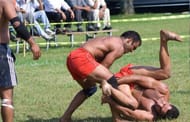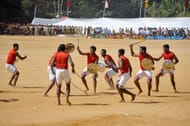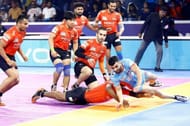With the Indian sporting fraternity oblivious of what lay ahead, it was business as usual in February 2020.
The Tokyo Olympics of 2020 were approaching and amid this, 28-year-old Srinivas Gowda from Karnataka became an overnight sensation. A clip of his record-breaking Kambala race went viral on social media. Srinivas Gowda broke the record for the fastest Kambala race in the history of the traditional sport of Karnataka, and had run 145 meters with his buffalo in just 13.62 seconds.
In a tearing hurry, which is symptomatic of our hoping against hope to see a fellow Indian as the fastest runner on the planet, many people on social media compared Srinivas Gowda with Usain Bolt. There were others who mocked at him for being unnecessarily compared with the Jamaican legend. But soon, there was a reality check.
Kambala involves the jockey driving a pair of buffaloes tied to the plough across the paddy field. In Kambala races, generally, two jockeys with the pair of buffaloes take on each other. Professor Gunapala Kadamba, president of the Kambala Academy, put the entire thing in perspective when he said:
'Both Srinivas Gowda and Usain Bolt are the masters of their own skill sets and comparison should not be made. Even tomorrow, if Bolt participates in Kambala, he couldn’t be like Srinivas Gowda.'
If we put the erroneous comparison out of the window, the entire episode once again highlighted the rich legacy of indigenous and traditional games which we have across the length and breadth of the country. More importantly, the superstructure of the strong sports nation could only be built on the solid infrastructure of the culture of sports.
In the rich legacy of the indigenous sport culture, we do have the potential which needs to be reinvigorated and reignited. Recently, in one of the noticeable initiatives in this direction, the Human Resource Development and Sports Ministry collaborated to produce a series of special films promoting 10 indigenous sports of India.
The series on the indigenous games was aimed at creating awareness about not just the games per se, but also the culture and heritage of the states to which they belong. The ten sports covered were - Kho Kho, Gatka, Kalaripayttu, Mallakhamb, Thang-Ta, Kabaddi, Roll Ball, Tug of War and Shooting ball.
Union Sports and Youth Affairs Minister, Shri Kiren Rijiju, talking about the initiative, said:
'There is a need to mass base these sports, just like other sporting disciplines. This initiative, in association with MHRD, is an attempt to reach out to young Indians and showcase the rich heritage of our indigenous games.'
In fact, even if we are successful in providing a mass base to some of the treasure trove of indigenous games we do have across the country, this has the potential to bring about the huge transformative changes in the ecosystem of Indian sport. All of us are witness to the latent power of Kabaddi when it was packaged and showcased in the format of the modern league. And this is just the tip of the iceberg.
It’s befitting that the indigenous games project is being promoted with the underlying narrative of ‘Ek Bharat, Shresth Bharat’.
The wealth of indigenous sports in the country

In 2014, when the public broadcaster of India decided to showcase the indigenous sport of the country, I was fortunate to travel extensively and understand first hand from the ground zero, the range and variety of these games spread across India. More importantly, they are intrinsically linked with the life and times of the people across generations, and this makes them the ready-made direct stakeholders.
The same amount of fan following takes years to be built in any of the modern sports. In fact, from North Eastern states of India which have the best sporting legacy of these games, to Gujarat, Jammu-Kashmir and Punjab in the north, to the deep-south, if these games are showcased properly, sports enthusiasts from across the globe could get the joy of the sports pilgrimage tour.
When we went to Karbi Anglong in Assam, we found a group of women amusing themselves with the 'dhup-khel'. This is a game of catch with the ball made of cloth. When we probed further, we found out that while it’s the cloth ball which is used these days, in the olden times, the ball was painstakingly made over days by layering a tomato with the glue from a banyan tree.
When the tomato would dry up, it made for the sturdy ball. Ising Bising is another game which is hugely popular amongst the small girls of the region. The girls form a pyramid and one has to jump over the other. These games act as a pastime and more importantly, provides a platform for these girls to express themselves. In this process, it empowers them.
When we went to the Namti village in Sivasagar district of Assam, we found large circular citrus fruit growing in almost every backyard. The fruit, popularly known as Rabatenga in Assamese, when mixed with salt, chilly powder and mustard oil makes for a pre-lunch snack.
Some of the residents informed us that once the lunch is over, the fruit becomes ‘Tenga Ball’ or ‘football. It is a different matter that these days, even in the remotest of the villages, kids play with a football and the tenga ball has disappeared. We are often told of the umpteen stories of kids honing their football skills with different objects in the streets of Latin American countries. It happens in different parts of India as well.
Along-dolong, a version of London bridge, luka-suri, hide and seek, konir jun i.e. egg fight or gila khel - a version of hopscotch played with a flattened seed of the tree - are some of the other popular traditional sports played in different regions of Assam.
Often, a single village in Assam has various tribes - Kalita, Hajong Rambha amongst others. Their festivals and food habits of these tribes may differ from each other, but when they get together to play, it does not matter who is Kalita and who is Hajong. The games act as a unifier. We found this narrative strikingly similar amongst various tribes of Meghalaya, Manipur, Mizoram and Arunachal Pradesh as well.
When we went to Aizawl, we met the leader of a clan who has chronicled more than 67 indigenous games played in the state. Some of the sports are still hugely popular; some has been transformed over the period of time, while there are others which have totally got lost in the transition.
Televising them is paramount

In November 2015, the public broadcaster of India, in direct collaboration with the locals, organized the first-ever indigenous games festival in Mizoram which was televised live. In the three-day festival, indigenous games like Insuknawr, Inkawibah, In-uilen, Sakei lem chan, Tira Mei Kaiah and Bingte sai rawkah were played in the picturesque ground and were televised live to a national audience.
While these sports were played in the middle of the picturesque ground, those who had come to cheer for their team patiently bought local handicrafts and tried different cuisines in various stalls around the ground. Whereas the youngsters were enthused to see their game getting such an attention on the national stage, the elders relived the memories of their times with an unmatched sense of pride.
Manipur’s legacy of indigenous sports is far richer and varied, explaining the strong culture of sport in the state. The state has one of the oldest polo grounds in the world and they do strongly believe that the game is their gift to the entire world.
Traditional records mention sangol kangjei - a Manipuri game which gave birth to modern polo. It was the Britishers who first took interest in the local game played by the ethnic majority - the Meiteis. English officers who were stationed in the region formalized the game and took it to the other countries.
In the second edition of the Indigenous Games festival organized in Imphal, Mukna - a form of Manipuri wrestling, Mukna Kangei - a combination of wrestling and hockey, Sagoi Kangei - Manipuri polo, Huyangtanaba - boat race and Yubi Lakoi - capture of coconut, among others, were showcased.
The participation of the people across different age groups, both men and women, both as players and as spectators has to be seen to be believed.
From the north east, as we went to the ‘Deep South’, we found the flavor and form of the game changing, but fervor, enthusiasm and energy levels remained the same. Seval sandai or cock fighting is the popular rural sport of Tamil Nadu. Three or four inch blades are attached to the cock’s feet and the winner is decided after three or four rounds of no hold barred fighting.
The sport which finds mention in ancient Tamil literature was the favorite pastime of the Tamil warriors and acknowledged amongst 64 great arts. Jalikattu is the popular bull taming sport practiced particularly during the Pongal festival. Rekhla is a sport which is a sort of bullock cart racing. The origin of Malyutham -the art of full contact or grappling - is Tamil Nadu.
In North India, Kushti or wrestling is popular, and in South India, Gusthi or a form of boxing is practiced extensively in the rural areas of Tamil Nadu. There are some traditional games which are the perfect amalgamation of different sport forms.
Mallakhamb is the combination of Yoga, gymnastics and martial arts. Its origin could be traced to Maharashtra and the exercises of the poles of Mallakhamb and rope are played against gravity in upward and downward movements. In a nutshell, we do have a huge treasure trove of indigenous sports waiting to be showcased to a national and international audience.
How can showcasing indigenous games catapult India to a great sporting nation?

Firstly, Australia had developed ‘The Yulunga’ traditional indigenous games to provide all Australians with a greater understanding and appreciation of indigenous culture.
Taking a cue from them, we could start a nationwide project comprising of both the practical and theoretical aspects of these games, and make it an essential part of the curriculum. This will help the coming generation to acknowledge and respect the traditional custodians of our great land and promote the culture of sport and fitness in our country, where more than half of our population comprise of those in impressionable age.
The practical aspects of these games will improve the basic fundamentals required for excellence in sports and could be incorporated in the training methods of the popular sport as well.
Secondly, providing a mass base and national audience to these games will help in building bridges amongst different communities across the country. It will provide a sense of belonging to the different communities. It will also go a long way in connecting generations.
Thirdly, many of these games like Kabaddi have the potential to find national and eventually international traction. If we are willing to be vocal about some of these local sports, it could add on to India’s contribution in the repertoire of the popular universal sports. Like Usain Bolt and Roger Federer, we will have global sporting icons like Srinivas Gowda and Rakesh Kumar in these sports.
Fourthly, our film and entertainment industry should be incentivized to promote these sports and bring it to a larger audience. If we could be so fascinated with tomato and bull races in other countries, we should be confident of the fact that there is a huge sports legacy which is far more fascinating and captivating.
Lastly, India could aspire to be the sporting hub of the indigenous games in the world. Like Brazil organized the first ever world indigenous games, India could play host as well and aspire to be its flag bearer with a huge middle class population, as well as a rich legacy and history.
Indigenous games could indeed be the game changer in Indian sport.
